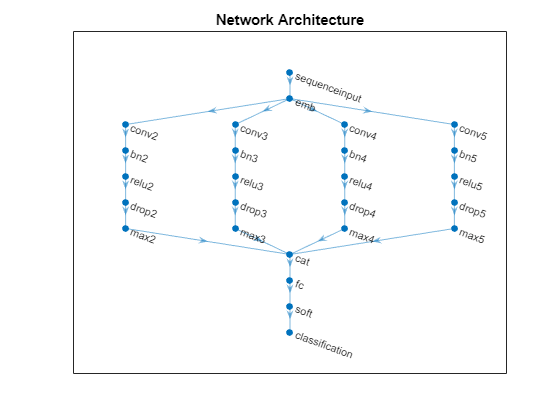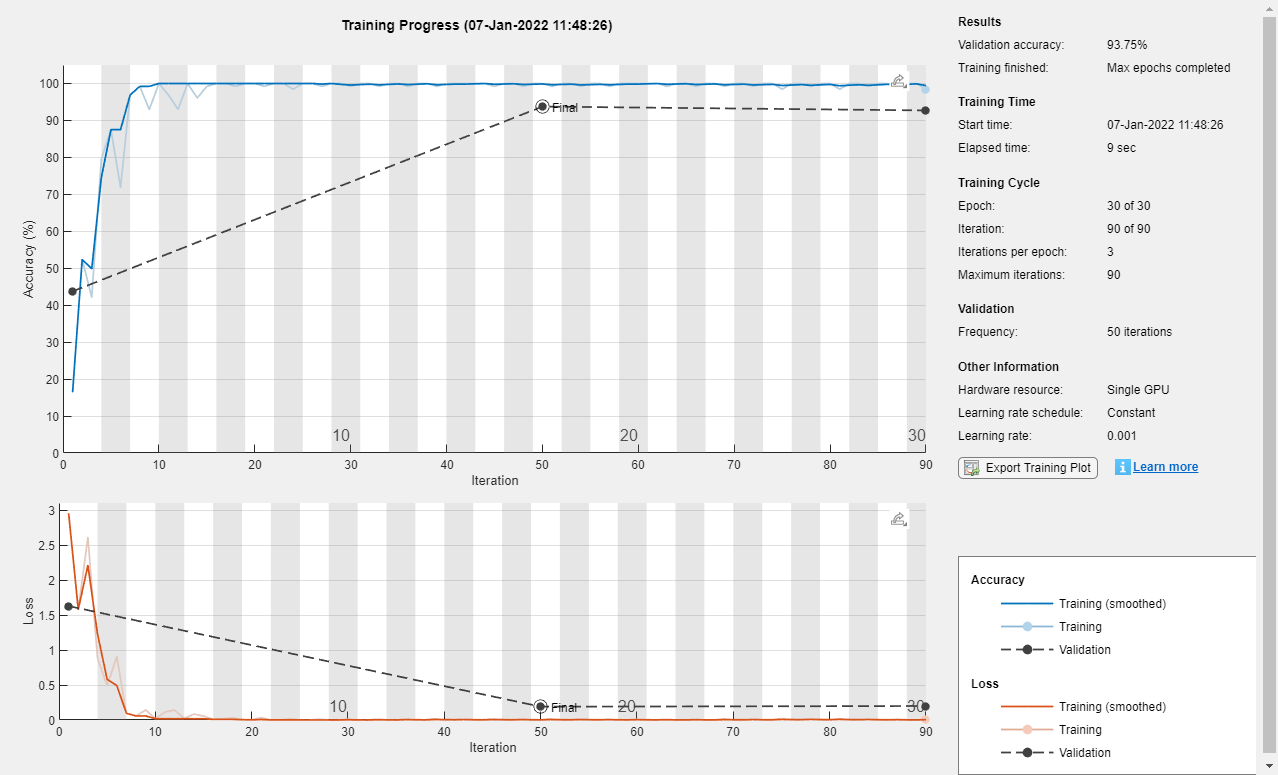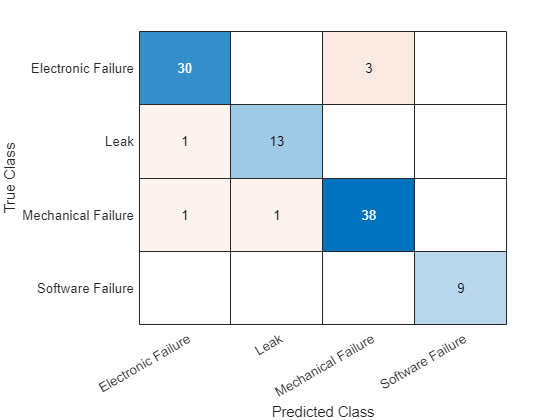Classify Text Data Using Convolutional Neural Network
This example shows how to classify text data using a convolutional neural network.
To classify text data using convolutions, use 1-D convolutional layers that convolve over the time dimension of the input.
This example trains a network with 1-D convolutional filters of varying widths. The width of each filter corresponds the number of words the filter can see (the n-gram length). The network has multiple branches of convolutional layers, so it can use different n-gram lengths.
Load Data
Create a tabular text datastore from the data in factoryReports.csv and view the first few reports.
data = readtable("factoryReports.csv");
head(data)ans=8×5 table
Description Category Urgency Resolution Cost
_______________________________________________________________________ ______________________ __________ ______________________ _____
{'Items are occasionally getting stuck in the scanner spools.' } {'Mechanical Failure'} {'Medium'} {'Readjust Machine' } 45
{'Loud rattling and banging sounds are coming from assembler pistons.'} {'Mechanical Failure'} {'Medium'} {'Readjust Machine' } 35
{'There are cuts to the power when starting the plant.' } {'Electronic Failure'} {'High' } {'Full Replacement' } 16200
{'Fried capacitors in the assembler.' } {'Electronic Failure'} {'High' } {'Replace Components'} 352
{'Mixer tripped the fuses.' } {'Electronic Failure'} {'Low' } {'Add to Watch List' } 55
{'Burst pipe in the constructing agent is spraying coolant.' } {'Leak' } {'High' } {'Replace Components'} 371
{'A fuse is blown in the mixer.' } {'Electronic Failure'} {'Low' } {'Replace Components'} 441
{'Things continue to tumble off of the belt.' } {'Mechanical Failure'} {'Low' } {'Readjust Machine' } 38
Partition the data into training and validation partitions. Use 80% of the data for training and the remaining data for validation.
cvp = cvpartition(data.Category,Holdout=0.2); dataTrain = data(training(cvp),:); dataValidation = data(test(cvp),:);
Preprocess Text Data
Extract the text data from the "Description" column of the table and preprocess it using the preprocessText function, listed in the section Preprocess Text Function of the example.
documentsTrain = preprocessText(dataTrain.Description);
Extract the labels from the "Category" column and convert them to categorical.
TTrain = categorical(dataTrain.Category);
View the class names and the number of observations.
classNames = unique(TTrain)
classNames = 4×1 categorical
Electronic Failure
Leak
Mechanical Failure
Software Failure
numObservations = numel(TTrain)
numObservations = 384
Extract and preprocess the validation data using the same steps.
documentsValidation = preprocessText(dataValidation.Description); TValidation = categorical(dataValidation.Category);
Convert Documents to Sequences
To input the documents into a neural network, use a word encoding to convert the documents into sequences of numeric indices.
Create a word encoding from the documents.
enc = wordEncoding(documentsTrain);
View the vocabulary size of the word encoding. The vocabulary size is the number of unique words of the word encoding.
numWords = enc.NumWords
numWords = 436
Convert the documents to sequences of integers using the doc2sequence function.
XTrain = doc2sequence(enc,documentsTrain);
Convert the validation documents to sequences using the word encoding created from the training data.
XValidation = doc2sequence(enc,documentsValidation);
Define Network Architecture
Define the network architecture for the classification task.
The following steps describe the network architecture.
Specify an input size of 1, which corresponds to the channel dimension of the integer sequence input.
Embed the input using a word embedding of dimension 100.
For the n-gram lengths 2, 3, 4, and 5, create blocks of layers containing a convolutional layer, a batch normalization layer, a ReLU layer, a dropout layer, and a max pooling layer.
For each block, specify 200 convolutional filters of size 1-by-N and a global max pooling layer.
Connect the input layer to each block and concatenate the outputs of the blocks using a concatenation layer.
To classify the outputs, include a fully connected layer with output size K, a softmax layer, and a classification layer, where K is the number of classes.
Specify the network hyperparameters.
embeddingDimension = 100; ngramLengths = [2 3 4 5]; numFilters = 200;
First, create a layer graph containing the input layer and a word embedding layer of dimension 100. To help connect the word embedding layer to the convolution layers, set the word embedding layer name to "emb". To check that the convolution layers do not convolve the sequences to have a length of zero during training, set the MinLength option to the length of the shortest sequence in the training data.
minLength = min(doclength(documentsTrain));
layers = [
sequenceInputLayer(1,MinLength=minLength)
wordEmbeddingLayer(embeddingDimension,numWords,Name="emb")];
lgraph = layerGraph(layers);For each of the n-gram lengths, create a block of 1-D convolution, batch normalization, ReLU, dropout, and 1-D global max pooling layers. Connect each block to the word embedding layer.
numBlocks = numel(ngramLengths); for j = 1:numBlocks N = ngramLengths(j); block = [ convolution1dLayer(N,numFilters,Name="conv"+N,Padding="same") batchNormalizationLayer(Name="bn"+N) reluLayer(Name="relu"+N) dropoutLayer(0.2,Name="drop"+N) globalMaxPooling1dLayer(Name="max"+N)]; lgraph = addLayers(lgraph,block); lgraph = connectLayers(lgraph,"emb","conv"+N); end
Add the concatenation layer, the fully connected layer, the softmax layer, and the classification layer.
numClasses = numel(classNames);
layers = [
concatenationLayer(1,numBlocks,Name="cat")
fullyConnectedLayer(numClasses,Name="fc")
softmaxLayer(Name="soft")
classificationLayer(Name="classification")];
lgraph = addLayers(lgraph,layers);Connect the global max pooling layers to the concatenation layer and view the network architecture in a plot.
for j = 1:numBlocks N = ngramLengths(j); lgraph = connectLayers(lgraph,"max"+N,"cat/in"+j); end figure plot(lgraph) title("Network Architecture")

Train Network
Specify the training options:
Train with a mini-batch size of 128.
Validate the network using the validation data.
Return the network with the lowest validation loss.
Display the training progress plot and suppress the verbose output.
options = trainingOptions("adam", ... MiniBatchSize=128, ... ValidationData={XValidation,TValidation}, ... OutputNetwork="best-validation-loss", ... Plots="training-progress", ... Verbose=false);
Train the network using the trainNetwork function.
net = trainNetwork(XTrain,TTrain,lgraph,options);

Test Network
Classify the validation data using the trained network.
YValidation = classify(net,XValidation);
Visualize the predictions in a confusion chart.
figure confusionchart(TValidation,YValidation)

Calculate the classification accuracy. The accuracy is the proportion of labels predicted correctly.
accuracy = mean(TValidation == YValidation)
accuracy = 0.9375
Predict Using New Data
Classify the event type of three new reports. Create a string array containing the new reports.
reportsNew = [
"Coolant is pooling underneath sorter."
"Sorter blows fuses at start up."
"There are some very loud rattling sounds coming from the assembler."];Preprocess the text data using the preprocessing steps as the training and validation documents.
documentsNew = preprocessText(reportsNew); XNew = doc2sequence(enc,documentsNew);
Classify the new sequences using the trained network.
YNew = classify(net,XNew)
YNew = 3×1 categorical
Leak
Electronic Failure
Mechanical Failure
Preprocess Text Function
The preprocessTextData function takes text data as input and performs these steps:
Tokenize the text.
Convert the text to lowercase.
function documents = preprocessText(textData) documents = tokenizedDocument(textData); documents = lower(documents); end
See Also
fastTextWordEmbedding (Text Analytics Toolbox) | wordcloud (Text Analytics Toolbox) | wordEmbedding (Text Analytics Toolbox) | layerGraph | convolution2dLayer | batchNormalizationLayer | trainingOptions | trainNetwork | doc2sequence (Text Analytics Toolbox) | tokenizedDocument (Text Analytics Toolbox) | transform
Related Topics
- Classify Text Data Using Deep Learning (Text Analytics Toolbox)
- Create Simple Text Model for Classification (Text Analytics Toolbox)
- Analyze Text Data Using Topic Models (Text Analytics Toolbox)
- Analyze Text Data Using Multiword Phrases (Text Analytics Toolbox)
- Train a Sentiment Classifier (Text Analytics Toolbox)
- Sequence Classification Using Deep Learning
- Datastores for Deep Learning
- Deep Learning in MATLAB
